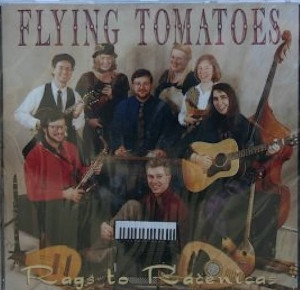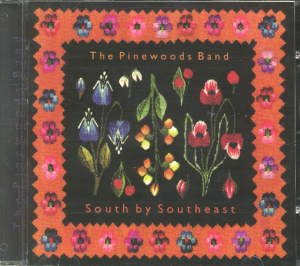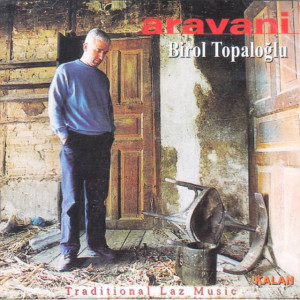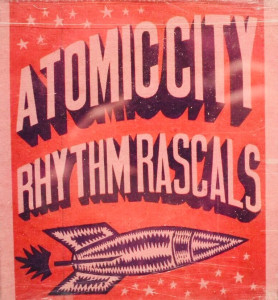 One cannot live by English and Celtic music alone, so there needs to be music outside those traditions that’s interesting too. For me, that music is that of the Central European region. And what I like best is the dance music that has become part of the arts scene here in the northeastern USA. This review will look at two CDs from efforts led by Tom Pixton of Flying Tomatoes infamy, and a number of CDs from the Central European region. All of these CDs are very, very good – great for dancing and superb for just listening to! Hell, I may even discuss dance music from other regions! You’ll just have to read on to see what tickles my fancy.
One cannot live by English and Celtic music alone, so there needs to be music outside those traditions that’s interesting too. For me, that music is that of the Central European region. And what I like best is the dance music that has become part of the arts scene here in the northeastern USA. This review will look at two CDs from efforts led by Tom Pixton of Flying Tomatoes infamy, and a number of CDs from the Central European region. All of these CDs are very, very good – great for dancing and superb for just listening to! Hell, I may even discuss dance music from other regions! You’ll just have to read on to see what tickles my fancy.
Flying Tomatoes’ Rags to Racenicas
Ah, the Flying Tomatoes. In 1992 Tom Pixton founded Flying Tomatoes which is, according to his web site “an ensemble devoted to providing live music of high energy and quality for international folk dancing. Flying Tomatoes plays every month for the Folk Arts Center of New England, and has played in a variety of other venues in the northeastern U.S.” Rags to Racenicas is their only CD to date, and a damn fine album it is. Released in 1995, this band easily fits Michael Jones’ FHL (Faster Harder Louder) style of good music. Now don’t get alarmed, this is still fine dance music, but it’s closer to the Blowzabella end of the dance music music continuum than it is to the contra dance end. (Yes, Blowzabella is now just a dance band, according to Andy Cutting; no more concerts for them!)
Lots of instruments are played with great verve here. I see santouris, basses, dumbeks, pianos, guitars, percussion, clarinets, saxes, fiddles, Scottish small pipes (!), pan flutes, accordions, tamburas, trombones, mandolins, madolas, recorders, and even banjos! And lots of vocalists to boot! So how do they sound? The answer is simple: they are a high-spirited, uptempo dance band that clearly knows its Central European music but is not slavish to it. They prove this in their playing of “The Levi Jackson Rag,” which very nicely sounds like a ragtime band filtered through a Klezmer sensibility. I also liked their inclusion of two sets of Irish waltzes – nice touch!
 Pinewoods Band’s South by Southeast
Pinewoods Band’s South by Southeast
Pinewoods Band is also a Tom Pixton venture. Much more traditional than Rags to Racenicas, this is just the music of Southern Europe – Bulgarian, Romanian, Macedonian, Greek, and Serbian material are all included here. At its heart, this is yet another dance band. As Tom notes on his web site: “In 1992, [I] was asked by the Folk Arts Center of New England to organize the music for their summer dance camps held at Pinewoods Camp, in Plymouth, Massachusetts. Under [my] leadership, the band already in place was reorganized and enhanced to play for all the dance sessions, as well as for the new material introduced by the teachers. The Pinewoods Band has since become legendary for their versatility, endurance and wit, and is the first international folk dance band to be engaged to play at festivals throughout the U.S. and Canada.”
This band has Julia Poirer and the couple of Barbara and Tom Pixton as does the Flying Tomatoes; otherwise it’s a different group. And it’s a much sparser sound with much fewer instruments. Think of it as a Raggedy Rawney sort of band, and you’d be very close to its sound. I can picture this band late at night in some smoky, ill-lit Greek cafe trading tunes with a local folk violinist while knocking back shots of Retsina Kourtak. Flying Tomatoes is more fun-sounding, but the Pinewoods Band sounds more authentic.
See this web site for details on purchasing these CDs!
 Mukka’s Skip Lizard
Mukka’s Skip Lizard
Skipping over to London, we find Skip Lizard by Mukka, a Klezmer band. Klezmer is an interesting music genre. As Ari Davidow notes on The Klezmer Shack web site: “klezmer is a popular music form that is no longer exclusively Jewish, and other forms of Jewish music are also gaining in popularity. And no one questions the place of klezmer in both Jewish and popular cultures. Well, no one we care about. Meanwhile, the edges of musical and cultural boundaries continue to change, expand, and morph onward, fuelled by the imperatives to explore new music on the one hand, and by the shifting sense of Jewish identity on another, not always related, hand.”
The Cat, Horse, and Tree label web site says “The inspiration for this band began with the Doppelganger Gypsy Orchestra, an eclectic melee of musicians who met regularly in a candlelit warehouse at Kings Cross. Sometime later, from a chance meeting at a party in south London, emerged ‘Mukka’. Soon the unpredictable rhythms of Balkan Horas and Rachenitsas and the lazy curls of the Arabesques were persuading Londoners, previously used to the slavish beats of the turntable to run to the dance floor.”
The CD leads off with “Skip Lizard,” a tune composed by the group’s accordionist Philippe Wittwer. Next up is a delightfully upbeat Laz tune “Serga,” demonstrating the talents of Frazer Watson followed by the two klezmer pieces, “Skotshne/Thalassa,” with a completely thrilling performance by flutist Sarah Chilvers. What I like about klezmer music is that it somehow manages not to take itself too seriously. Sometimes the weight of history itself, such as Ireland’s, causes the music to become a bit too self-important. Mukka sounds like they’re having fun! Their explanation of what Mukka means underscores this playfulness: “In Slovak, ‘mukka’ means emotional pain and in a Berber dialect, chameleon; and in cockney rhyming slang it means friend.” It certainly is good enough that it has become part of the collection in my house!
 Birol Topaloğlu’s Aravani
Birol Topaloğlu’s Aravani
Laz bagpipes! Yes and yes and yes! Well, I got them very nicely in a package of CDs direct from Turkey.
Birol Topaloğlu is a Laz musician who is a resident of Turkey. He and what appears to be a group of musician friends – think lots of really interesting sounding instruments including aforementioned bagpipes – recorded Aravani, a most tasty album. As Birol notes in an online interview with a NTV/MSNBC interviewer: “I never thought of myself as a professional musician or an artist,” he answered. “I was born in Turkey just like everyone else, but as a child of a Laz family. However since we did not have a chance of being educated in our mother tongue I learned how to speak Laz at school. My native language is Laz and I learned Turkish after the age of six. At that time I never thought Laz music and culture would ever become a part of world heritage. I got a hold of a bağlama (a typical Laz plucked musical instrument with three double strings) and started to play and as I thought it was all a hobby it became more serious. My family was fairly instrumental in my taking up the bağlama. I used to just play the bağlama and give concerts at university. Since Laz was not an acceptable language to sing in, I always faced bans on my use of the Laz language in music. These were all reasons preventing the music from coming into daylight.” He goes on to note in the interview that “The biggest example and inspiration for me are the songs I hear from old ladies and shepherds in villages in the Black Sea region…”.
If this is true, this is some of the finest roots music I’ve heard! There’s not a bad note, not a less than great vocal, on Aravani. All in all, a very sweet CD with bagpipes (YES!) that are very similar to the pipes Jon Swayne created for Blowzabella and the Eel Grinders a winding, snakish sort of sound quite unlike anything else I’ve heard.
You can purchase this CD from the label.
 Atomic City Rhythm Rascals’ Atomic City Rhythm Rascals
Atomic City Rhythm Rascals’ Atomic City Rhythm Rascals
And now for something completely different! Well, sort of. We also get a lot of independent CDs from American contra dance and English “barn dance” groups, which quite frankly are better than most of what the major music companies release these days. For example, take Atomic City Rhythm Rascals. This all-acoustic instrumental CD from a contra dance group based in Knoxville, Tennessee is an anthology of recordings made by the group made over the past three years. It includes 10 tracks from the band’s 1998 studio-recorded cassette Two Steps Back, live recordings from Split Tree Farm music venue in their hometown and the Laurel Theatre, and new studio recordings. The arrangements range from solo performances (banjo, guitar) to duets (concertina/hammer dulcimer, fiddle/banjo) to trios (fiddle/banjo/bass) to the full quartet sound. You get nearly 70 minutes of really tasty dance tunes and a few ballads. Their web site notes that “ACRR have been in their present form since 1997. The band began as an old-time string band playing for dances, and traditional mountain-style dance music remains the core of their repertoire. The band’s members also draw on other instrumental traditions & emdash; Celtic, bluegrass, and jazz & emdash; and these influences all appear on the recording.” This group reminds me strongly of the Red Clay Ramblers and the Horseflies as they mix their traditional material with a cutting sense of humor! And yes, it’s quite danceable!
 Stömp’s Machine Without Horses
Stömp’s Machine Without Horses
Bloody good Stömp! Eh? Sorry I need to explain that remark. Stömp’s a band from England that – with the dubious exception of “Pachelbel’s Canon” – has released a rather good album of dance music entitled Machine Without Horses. Their web site says they are “a tight, energetic rock-based English Country Dance Band,” and I won’t disagree, although this really is more of a folk rock group.
Their material’s very much the traditional material of the British Isles, Europe and Scandinavia. I don’t think they are anything like the Central European centered Tiger Moth, but they are another FHL group. Only five members, but they certainly are as loud of Blowzabella was on Pingha Frenzy or Vanilla. Stömp has a slight Central European feel on certain cuts, i.e. “North Country Polka/Mother Russia” but this is, at its heart, a bleedin’ good English Country Dance Band. Everything here is quite nice, but I really could have done without the inclusion of “Pachelbel’s Canon”! The bottom line is that Machine Without Horses has become a favourite album in our household.
Stömp’s web site is here!
All of these CDs are well worth your time to search out and listen to.
(NightShade Productions, 1995)
(NightShadeProductions, 1999)
(Cat, Horse, and Tree, 2000)
(Kalan, 2000)
(Grinning Deer Music, 2001)
(Working Party Music, 1999)
